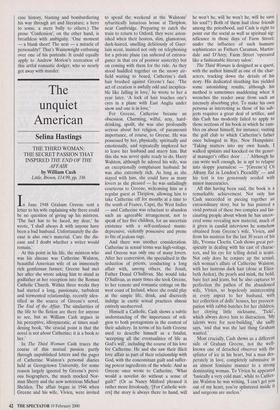A highly sensitive artist in crime
William Scammell
WAINEWRIGHT THE POISONER by Andrew Motion Faber, £20, pp. 305 For this spiritual voluptuary, with the greedy senses, soft coat and tiger heart, painted and exhibited as well as wrote.' That's Gilchrist on Wainewright, in his Life of Blake. You can almost see him choking with indignation. How dare anyone hide their wickedness behind the fine arts, mixing up virtue and vice? Wainewright, he goes on, wrote 'smart, harum-scarum arti- cles' for the London Magazine, which nonetheless had sufficient 'literary merit and originality' to win him the friendship of Lamb, Coleridge, De Quincey, Clare and Blake himself, 'whom he assisted by buying two or three of his expensive illustrated books', including one of the best copies of Songs of Innocence and Experience.
It soon became apparent, however, how expensive tastes for fine prints, rare books, articles of virtu, on the one hand; for mere elegant living on the other; for combining, in short, the man about town and the man of refined taste and high sympathies, led him into inevitable money difficulties, into shifts of all kinds, and convulsive efforts to raise the wind. Gilchrist then summarises his scan- dalous career — how he poisoned a young and beautiful sister-in-law after taking out insurance policies worth £18,000 — was seen 'skulking about France a few years, with a bottle of strychnine in his pocket'; was eventually convicted of forgery and transported to Australia — and muses on the 'ghastly motley' of his life, 'as if every step was taken among things dead and doomed'.
It's precisely this motley that attracts Andrew Motion to the real and conjec- tural events of his life. Thomas Wainewright (1794-1847) forged deeds on a trust fund, enabling him to inherit a handsome house in Chiswick; and three of his close relatives died in suspicious circumstances. Talfourd, De Quincey, Bul- wer Lytton, Dickens, Oscar Wilde all seized on the story with horrified fascina- tion, just as Gilchrist does. How could someone who 'piqued himself on being the gentleman', who 'claimed a soul sympa- thising with . . . all high things', turn out to be a dyed-in-the-wool villain? Can a man with refined taste also be a blackguard? Is there no visible dividing line between the connoisseur and the 'voluptuary'? Is art itself implicated in immorality, gentleman- liness no more than the wherewithal to indulge dubious pleasures?
These worries are a very English kettle of fish. Small wonder Dickens smelled out something interesting in it, and that Wilde was more than happy, as Motion says, to make him 'the subject of a brilliant and mischievous essay'. In fact he plucks a sen- tence from the essay as one of his two epigraphs: 'The fact of a man being a poi- soner is nothing against his prose.' That insouciant separation of morals from aes- thetics is precisely what convulsed the Vic- torians and continues to agitate certain Anglo-Saxon critics from Matthew Arnold to John Berger and Terry Eagleton.
Seizing on this 'despicable outcast' as an exemplary figure — exemplary of what exactly is the business of the next 300 pages to establish — Motion argues in his fore- word that Wainewright 'shines a bright light' on his better-known contemporaries, `especially their preoccupation with the self:
His career dramatises ideas that deeply concerned Wordsworth, Coleridge, Byron, Keats, De Quincey, Lamb and many other Romantic writers and artists. By combining a life in culture with a life in crime, he embod- ies an extreme version of what they regarded as a general truth: that good and evil grow on the same stem.
The problem is that 'most of the materi- als essential to his biography were destroyed'. The letters and diaries have dis- appeared, so have most of the paintings. Consequently this book is 'an experiment' in 'biographical form', a fictional 'Confes- sion' by Wainewright himself 'which pur- ports to have been written . . . in Van Diemen's Land shortly before his death in 1847'. Each chapter is succeeded by a set of notes and sources on which the first-person narrative is based.
So far so interesting, though it seems to me that this 'Confession' has as much in common with the novel as it does with biography, and perhaps more. Margaret Forster did something rather similar with a fictional autobiography of Thackeray some years ago, though of course she had much more factual material to draw from. Here the challenge is to invent what can only be guessed at, and above all to create a voice for the excited and excitable young aesthete that will ring true.
Thus we get Wainewright the sensitive child and adolescent, Wainewright 'the bold lover', Wainewright the artist and live- ly companion of great men, Wainewright the rationaliser, and Wainewright the fall- en, complete with the (real) petition he addressed to the governor of Van Diemen's Land for a ticket of leave. The petition flourishes his gentlemanly descent, his cultural attainments, his famous friends, and his aversion to 'revolting and sordid Vice'. This is a prime document in evaluat- ing his character, and so is the self-portrait he painted in the 1840s, satirically labelled `Head of a Convict very characteristic of low cunning and revenge!' In it he looks remarkably like Robert Louis Stevenson, together with a dash of the young Wynd- ham Lewis. (There's another interesting case history, blasting and bombardiering his way through art and literature; a hero to some, a mere bully to others.) The prose 'Confession', on the other hand, is breathless with ambiguity. 'One moment — a blank sheet! The next — a miracle of personality!' That's Wainewright enthusing over one of his portraits. It could equally apply to Andrew Motion's recreation of this artful romantic dodger, who so nearly got away with murder.



































































 Previous page
Previous page